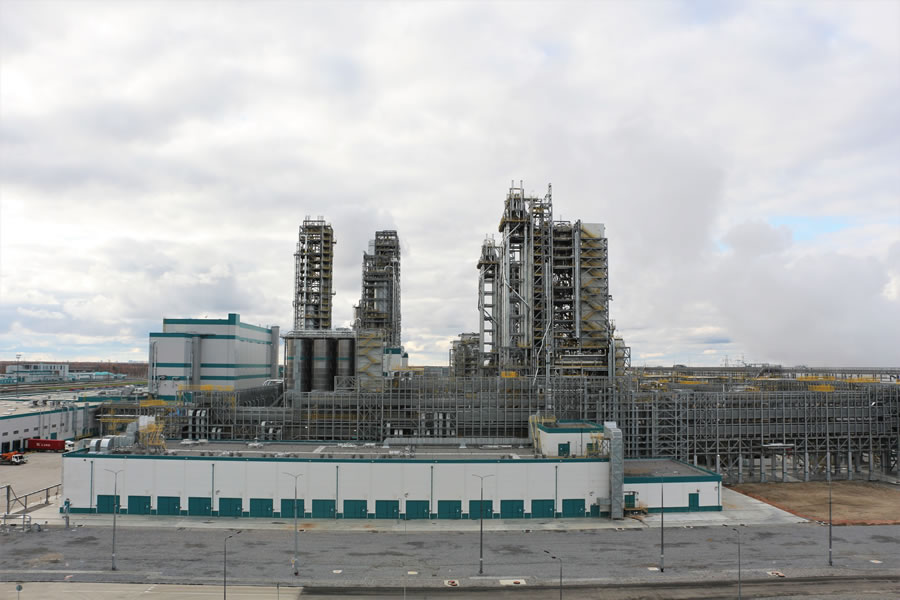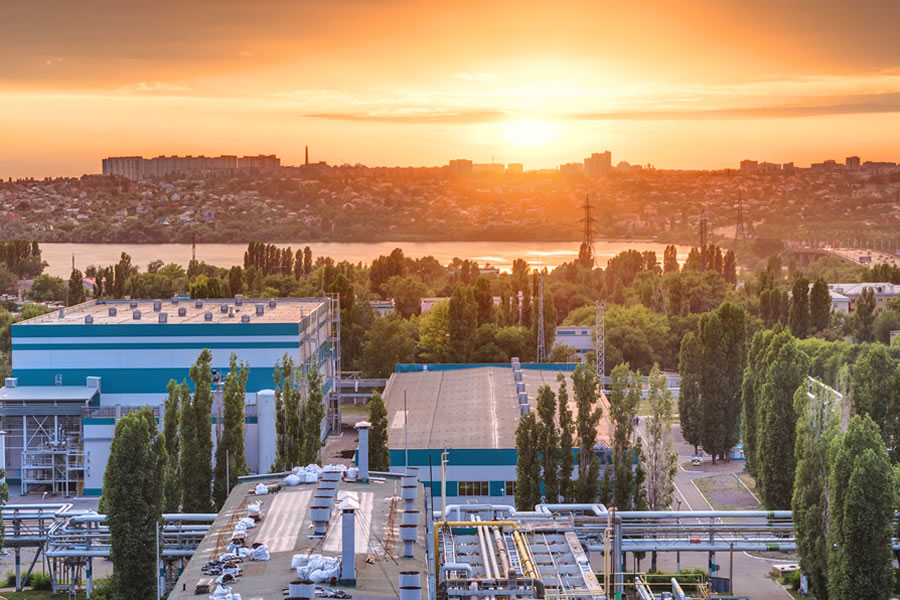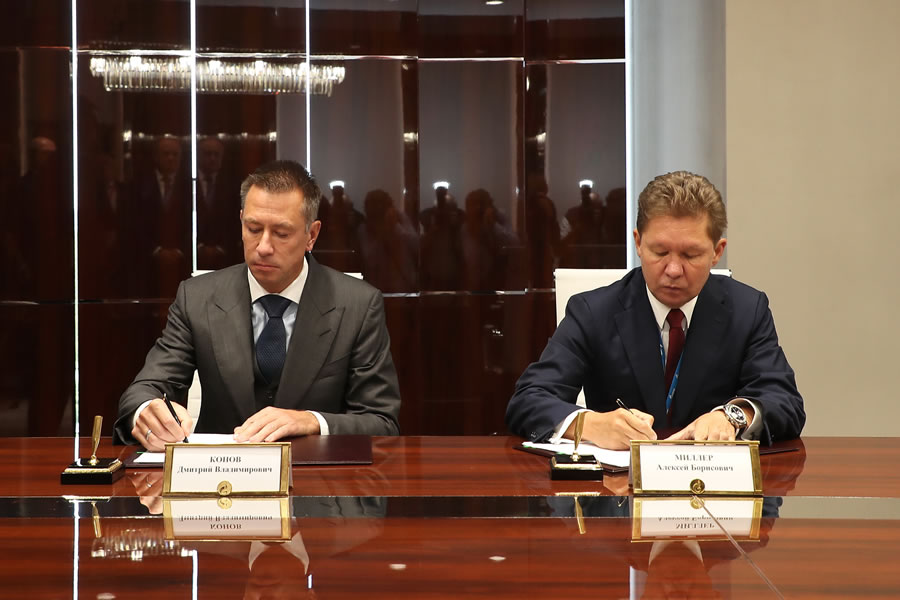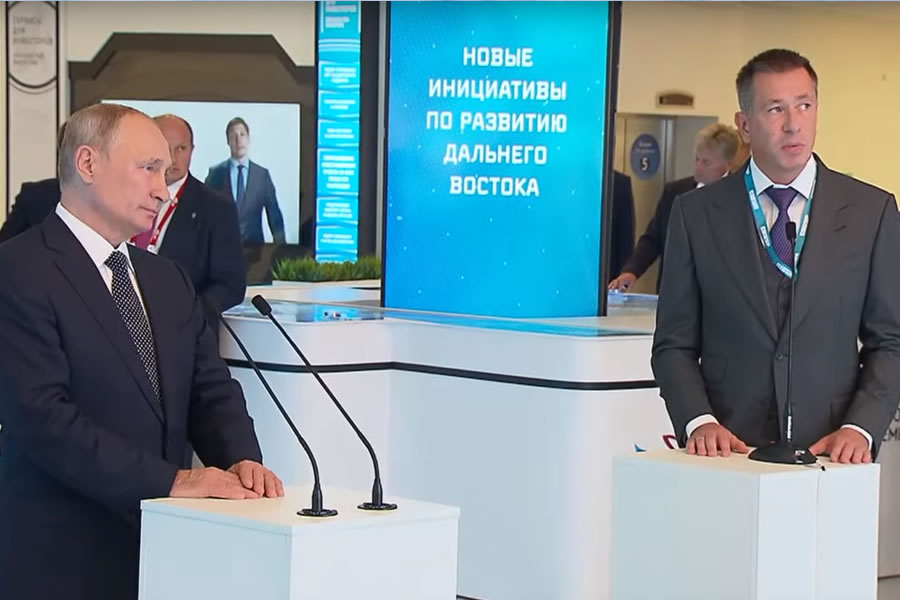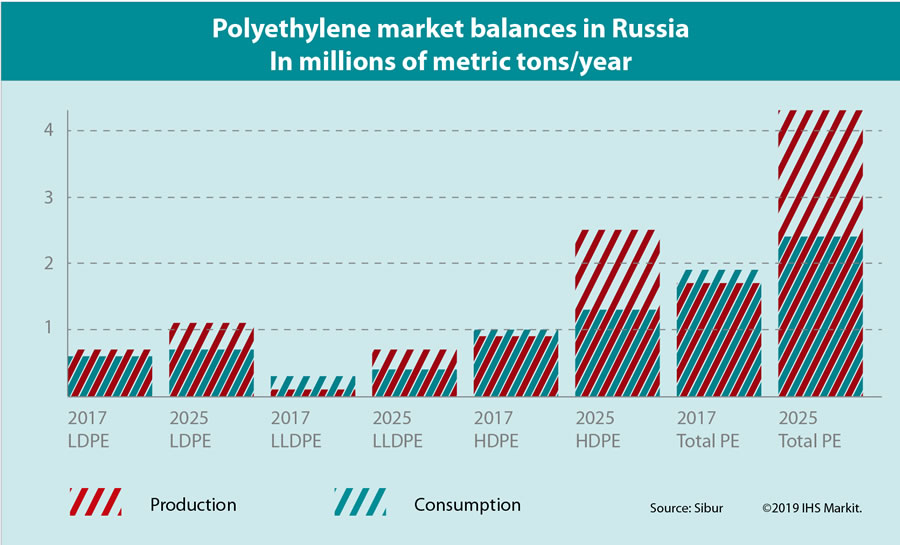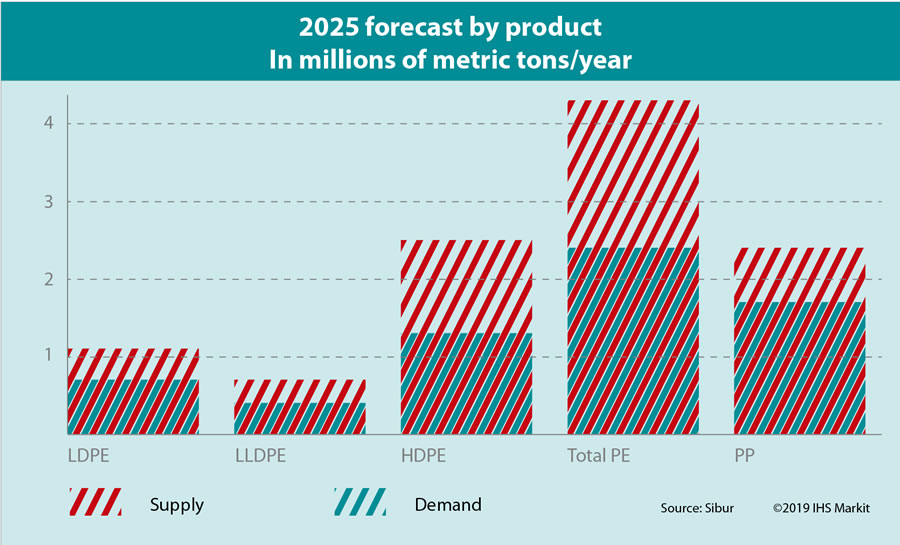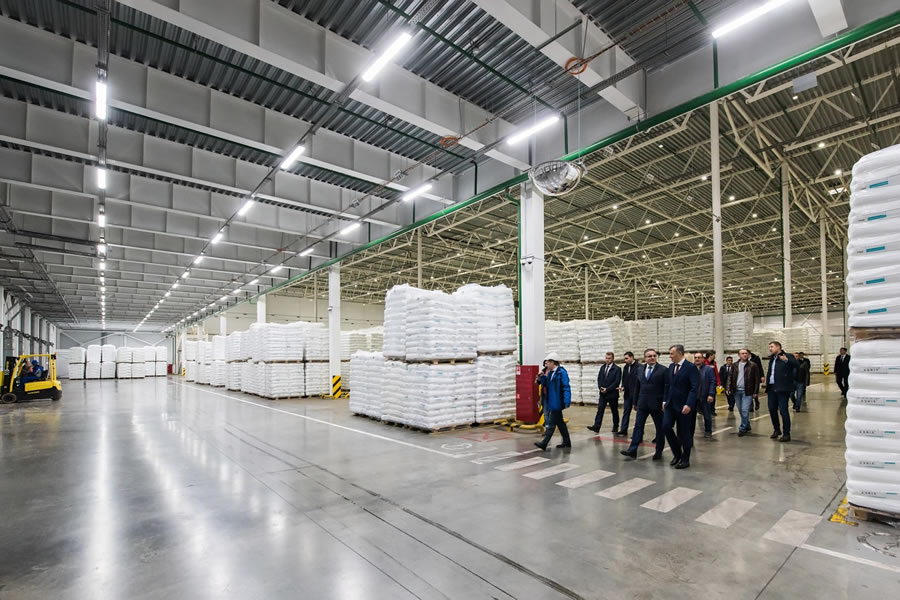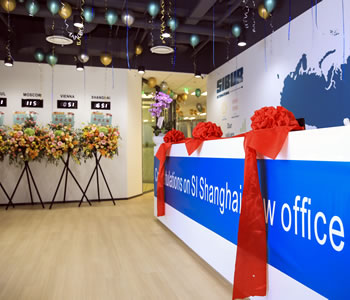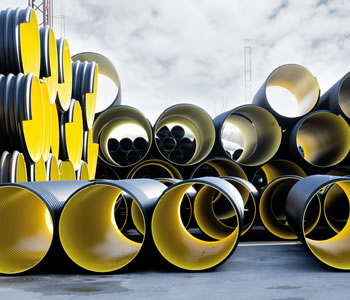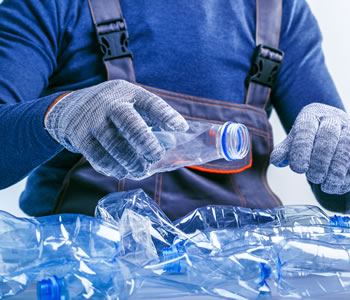Sergey Komyshan, member of the Management Board and Executive Director of SIBUR, told Chemical Week that the construction of ZapSibNeftekhim had been completed ahead of schedule, with the commissioning currently underway. Now SIBUR is planning to focus on another major project, the Amur Gas Chemical Complex (Amur GCC), provided that a relevant investment decision is adopted. In addition, the Company is working on sales infrastructure for ZapSibNeftekhim.
The ZapSib complex, completed ahead of schedule, is undergoing test runs and has produced over 20,000 metric tons of PP. The complex’s PE finishing line is being tested with PE powder obtained outside the company.
Once launched, ZapSibNeftekhim will increase SIBUR’s annual output of polyethylene and polypropylene to 1.77 mt and 1.50 mt, accordingly.
ZapSib is designed to produce 1.5 million metric tons/year (MMt/y) of ethylene, 500,000 metric tons/year of propylene, 1.5 MMt/y of PE, and 500,000 metric tons/year of PP. Its centerpiece nine-furnace ethylene plant, based on Linde technology, is Russia’s largest by far and, when commissioned, will be the first grassroots cracker to come onstream in the country since the Soviet era.
It is designed to crack 2.7 MMt/y of LPG–butane and propane–and 300,000–400,000 metric tons/year of ethane, and will reduce Sibur’s sales of LPG to third parties accordingly. The polyolefin plants are based on Inovyn gas-phase and slurry PE technology and the LyondellBasell Spheripol PP process.
ZapSib will raise Sibur’s PE and PP capacity to 1.77 MMt/y and 1.50 MMt/y, respectively. The PP total includes 500,000 metric tons/year from Tobolsk Polypropylene, which completed its plant, based on Ineos technology, in 2013. Propylene feedstock is sourced from an adjacent UOP-process propane dehydrogenation unit, fed with about 610,000 metric tons/year of LPG.
ZapSibNeftekhim produces first polyethylene from its own feedstock.
The launch of ZapSibNeftekhim will increase the share of petrochemicals in the Company’s total revenue (USD 9.1 bn in 2018) from 50% to 70%.
“When ZapSib is fully onstream, we expect to triple our PE and PP business and grow our olefins and polyolefins segment margins, which currently stand at around 36%,” Komyshan says. One of the world’s lowestcost polyolefin plants, the existing Tobolsk PP facility has been achieving margins of 50% and is in the industry’s first quartile, he says. The new complex will “dramatically improve” Sibur’s margins since it will be the most profitable operation in the company’s portfolio and “definitely comparable with production in Saudi Arabia,” he adds. The complex will raise the share of petrochemicals in Sibur’s total revenue–$9.1 billion in 2018–from 50% to 70%.
ZapSib will also produce 95,000 metric tons/year of butadiene, which will be shipped to Sibur’s Voronezh thermoplastic elastomers (TPE) complex, the center of the company’s TPE production. A new, 50,000-metric tons/year styrene-butadiene-styrene TPE facility is under construction there. It will add to the two existing plants at the site, raising the total capacity to 135,000 metric tons/year.
The Voronezh site, SIBUR’s key thermoplastic elastomer production facility.
ZapSibNeftekhim will annually produce 95 kt of butadiene to meet the feedstock needs of the Voronezh TPE production site.
Although Sibur has been reducing its methyl tert-butyl ether (MTBE) footprint, the new Tobolsk complex will include an additional, small 13,000-metric tons/year MTBE plant, based on the increased feedstock availability. “We make MTBE at Tobolsk, Perm, and Togliatti and have a combined capacity of 340,000 metric tons/year,” Komyshan says.
Another plant to be built at Tobolsk will produce 45,000 metric tons/year of maleic anhydride, the first such unit in Russia. These plants are not the end of the Tobolsk story. Komyshan says that Sibur is carrying out feasibility studies for other projects at the huge site, which could include new as well as conventional products. “We believe that Tobolsk has potential for further growth thanks to its location, proximity to feedstock, and available land,“ he says.
Meanwhile, recruitment of personnel for ZapSib has been completed. The complex will employ 1,500 people, including 322 relocated from other Sibur sites. Komyshan says the numbers are on the high side but he expects some attrition to begin with and the total to be gradually reduced.
The Amur complex in Russia’s Far East, the next project on Sibur’s agenda, will be completely focused on Asia. It will be built at Blagoveshchensk on the Chinese border.
Sibur has awarded basic engineering design contracts to two competing ethylene technology owners – Linde and TechnipFMC – and will choose between them later. It has also selected the technology for the proposed PE manufacturing units.
At the Eastern Economic Forum held in Vladivostok earlier this month, Sibur and Gazprom (Moscow) signed contracts for additional feedstock supplies for the enlarged project. However, the size of the proposed capacity uplift is subject to the Russian government agreeing to align the tax treatment of LPG and naphtha. There is currently an effective negative excise duty on naphtha – a company receives remuneration from the government for every ton it processes.
Dmitry Konov and Alexey Miller signing a preliminary agreement at EEF 2019. Source: gazprom.ru.
Gazprom is building a huge gas-processing plant (GPP) near the site of the proposed Amur project, on the last mile of the Power of Siberia gas trunkline, which transports natural gas from the Irkutsk and Yakutia production centers to consumers in the Russian Far East and China. With a capacity of 42 billion cubic meters/year, it will be the largest GPP in Russia and the second-largest worldwide. It will include six processing lines, the first two of which will be commissioned in 2021. By-products of the complex will include about 2.5 MMt/y of ethane, 1.0 MMt/y of propane, 500,000 metric tons/year of butane, about 200,000 metric tons/year of pentane-hexane fraction, and 60 million cubic meters/year of helium. The helium will be supplied to Linde for marketing.
Under the original agreement between Sibur and Gazprom, Sibur was to source about 2 MMt/y of ethane for the Amur petchem complex. The new deal with Gazprom will give Sibur 1.5 MMt/y of LPG and some additional ethane, resulting in the total LPG capacity of the Gazprom GPP being consumed in the enlarged Amur complex.
Russia’s first maleic anhydride production facility with a capacity of 45 ktpa is being built in Tobolsk.
“The signing of the agreement opens up an opportunity for us to increase the amount of hydrocarbon feedstock to be processed in Russia. If we opt for the extended version of the project, LPG will be processed domestically instead of being exported, thus providing additional feedstock for related industries and enabling us to manufacture more high-tech export-oriented products,” said Dmitry Konov, chairman of Sibur, at the signing ceremony in Vladivostok.
The original plans for the Amur project envisaged constructing a 1.5-MMt/y ethylene plant, the entire output of which would be used to make 1.5 MMt/y of PE. The latest option envisages a near-doubling in capacity to 2.7 MMt/y of polyolefins, comprising 2.3 MMt/y of PE and 400,000 metric tons/year of PP, and an enlarged steam cracker to suppor the higher polyolefins production. Komyshan says that Sibur has selected the CPChem and Univation Technologies processes for the PE units, which will enlarge the company’s basket of PE technologies. The selection of PP technology is still under way. The extended configuration would make Amur the world’s largest polyolefin production site, the company says.
A final investment decision on the Amur project is expected by the end of this year or at the beginning of 2020, with start-up scheduled for 2024 to coincide with the completion of the Gazprom GPP.
Presenting the Amur GCC project at the Eastern Economic Forum.
The final investment decision on the Amur GCC project will be made by the end of 2019. The facility's launch is scheduled for 2024 to coincide with the commissioning of the fourth stage of Gazprom's Amur Gas Processing Plant.
Sinopec agreed in June 2019 to take a 40% share in the Amur project and will also help sell some of the PE from ZapSib in the Chinese market. Komyshan says that, while Sibur has been operating a world-scale PP complex at Tobolsk for a number of years and has experience in selling PP in international markets, it lacks similar experience in PE marketing.
Meanwhile, Sibur has been busy establishing the infrastructure needed to market product from the ZapSib complex in China, Turkey, Russia, and other Commonwealth of Independent States (CIS) countries, all of which are more or less equidistant from the Tobolsk site. Sinopec is expected to take about half the 1.5 MMt/y PE production and “Turkey may absorb about 200,000–300,000 metric tons/year, depending on market conditions,” Komyshan says. Turkey is also a target market for PP, he adds.
Komyshan is unconcerned about shipping costs. “We would get lower netbacks from our sales to outside markets than we would from the domestic market, because of the distance, but given our cost position, we will be profitable,” he says. Russia itself has a very low per-capita consumption of polyolefins, particularly of linear low-density polyethylene (LLDPE) (table, p.30). “We believe the market will grow when we commission our plants, as happened with our PP plant,” Komyshan says.
ZapSib has two slurry PE lines with a combined capacity of 700,000 metric tons/year, and two gas-phase PE lines with a capacity of 800,000 metric tons/year. The last two are swing units capable of producing LLDPE and high-density polyethylene (HDPE). Komyshan says the new capacity will transform Russia from a net importer to a net exporter of LLDPE.
A significant increase in the use of packaging materials along with the changes taking place in key industries such as car manufacturing, electronics, energy and healthcare, lead to higher polyolefin demand.
Rapid growth in packaging applications and changes in key industries including automotive, electronics, energy, and healthcare are driving growth in polyolefins demand at multiples to GDP in all markets worldwide, including Russia. Komyshan says Russia will serve this burgeoning demand by increasing exports of low-density polyethylene and PP, and changing from a net importer to a net exporter of LLDPE and HDPE.
As part of its marketing efforts, Sibur is quadrupling the number of people employed in its Vienna, Austria, sales office and has signed an agreement with Karl Schmidt Spedition (Heilbronn, Germany), a logistics group, which will build a hub within the Kaluga industrial zone, southwest of Moscow, to help distribute ZapSib product. Komyshan says that Sibur is also planning to move some of its sales fully onto its e-commerce platform.
While focusing on polyolefins and TPEs, medium-tonnage products and premium specialty chemicals, Sibur is reducing its synthetic rubber footprint. Capacity will be cut by approximately 40% from 580,800 metric tons/year when the agreement with Tatneft to sell the Togliatti site is finalized.
Sibur will receive a reported $150–200 million for the assets. Currently part of the Sibur Togliatti and Togliattisintez businesses, they include production facilities for several types of synthetic rubber used by domestic and foreign tire manufacturers; as well as for MTBE, butadiene, isoprene, and other intermediates. The deal is expected to close by the end of 2019. Through the acquisition, Tatneft will strengthen the vertical integration of its Kama Tires operation and says it intends to grow the business.
The launch of SIBUR’s polymer logistics hub in the Kaluga Region.
Sibur will divest capacity for 217,000 metric tons/year of various rubber products to Tatneft. This comprises 82,000 metric tons/year of isoprene rubber, 60,000 metric tons/year of styrene-butadiene rubber, and 75,000 metric tons/year of butyl rubber.
Later this year, Reliance Sibur Elastomers, a joint venture (JV) with Reliance Industries, will commission a 120,000-metric tons/year butyl rubber plant at Jamnagar, India. Saudi Arabia presents another opportunity, although plans are at a very early stage. Komyshan confirms that a feasibility study is under way to establish a JV synthetic rubber manufacturing project with Saudi Aramco and other partners.
Natasha Alperowicz
Source: Chemical Week.
Download PDF

